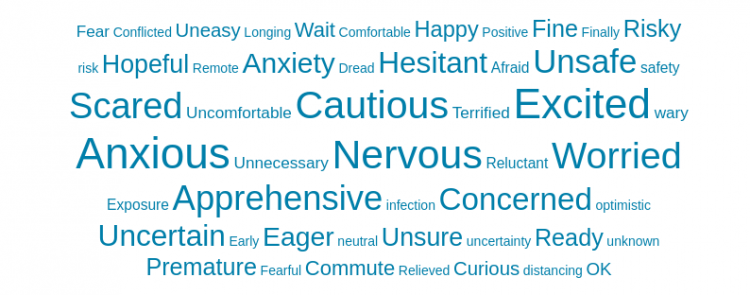One of the most important lessons I’ve learned during my nine years at SurveyMonkey is the importance of asking for input from employees, listening thoughtfully and using their feedback to help make important decisions. This is the core of our culture, and how we evolve our programmes, or build new ones, and it became even more critical as our Troop, and the world, adapted to the reality of a pandemic.
When the coronavirus crisis began, there were a million decisions that needed to be made, and we had to move quickly. Were employees set up to work from home? What could we do to support them? What concerns did they have about their job, the company or their work/life balance? That was where our coronavirus leadership check-in and manager check-in came in handy, and the results were incredibly valuable as we formed policies around remote work and addressed the challenges our employees faced.
But even during a crisis, we try to think a couple of steps ahead. Although we don’t know when the curve will flatten and the crisis will end, asking employees about returning to the office was the next logical step. Our leadership and HR teams recognised that we can’t expect to go back to “business as usual”. We need to reimagine what work looks like in the future, and to do that we need our Troop to weigh in and help us go back to something new and better.
We used our coronavirus returning to work check-in template to understand employees’ concerns, as well as what would make them feel more comfortable about getting back into the office when we are able to do so. Our Troop came up with the goods: 71% of our global workforce responded and we received a wealth of insight into what our employees are feeling.
Returning to the office affects people’s health and wellbeing, which makes it a deeply sensitive and personal issue. As organisations begin to think about how they’re going to return to the workplace, we believe that it’s essential to include employees in the discussion. Here’s what we learned from our own survey and how the results have sparked conversations and further exploration.
Anxiety is (understandably) still high
Our Troop’s overall reaction to returning to the office was caution, anxiety and uncertainty. Although people seem to be getting used to their “new normal” of remote work, with more reporting that they’re finding it easier to work effectively, the same issues persist: People cited general anxiety (48%), social isolation (43%) and finding the right work-life balance (36%) as the top three challenges they're facing while working remotely.
We also asked employees for one word to describe how they’re feeling about returning to the office. Although “anxious” and “excited” hold similar weight in the word cloud of responses, we also took a look at all the synonyms for “anxious”, and it was clearly an anxiety landslide.

What could we do to reduce anxiety?
When we asked what would make our employees feel more comfortable about returning to work, the data revealed:
- Availability of a vaccine (66%)
- Office hygiene protocols, such as nightly deep cleans (60%) and hand sanitiser stations (60%)
- Availability of antibody testing (58%)
- Limiting the number of employees in the building by staggering their hours or days (51%)
- Government guidance saying it is okay to return to work (49%)
While things like a vaccine or antibody testing are out of our control, it was helpful to gain a sense of the kind of office policies our employees would welcome or expect. We understand that implementing these policies will not make employees instantly comfortable and worry-free; however, they can serve as a guide and a springboard for moving forward.
Where to go from here
Considering how to return to the office when the coronavirus crisis subsides is an epically hard task, and as an HR leader, I feel a huge responsibility to put a plan in place for 1,300 people. This survey may not be a set-in-stone road map, but it is, in its own way, a compass. We can use the results now, to gain a better understanding of what support our employees need, and we can use them in the (hopefully) near-future, to strategise our return to the office.
For instance, our survey results made it clear that we should keep an eye on overall anxiety, social isolation and the potential for burnout. Fortunately, we already had a lot of topical programming planned, since May is Mental Health Month. This includes discussions around parenting, caregiving during COVID-19, and perceptions of work performance and mental health.
We also announced, in late April, that all employees are encouraged to take two paid “flex days” in Q2. These are intended for employees to use for self-care, care of others or to spend time doing things that support their mental wellbeing. Moving forward, we will continue to think about how we can support our Troop, asking ourselves if there are other resources or solutions we can provide.
The coronavirus crisis has made it clear that it’s more important than ever to connect with employees and thoughtfully consider how they’ll do their best work. Asking “how are you feeling?” and “what would make you feel comfortable?” builds a relationship of trust, and SurveyMonkey allows you to do that at scale and gain the feedback you need. There’s no playbook for dealing with this crisis or determining the best way to return to the office, but simply asking employees is a great place to start.
For more resources to help your organisation stay connected to your employees, customers and students during the coronavirus crisis, visit www.surveymonkey.com/coronavirus. You’ll find more details on our enterprise solutions for remote workforce monitoring and onsite healthcare monitoring here.



